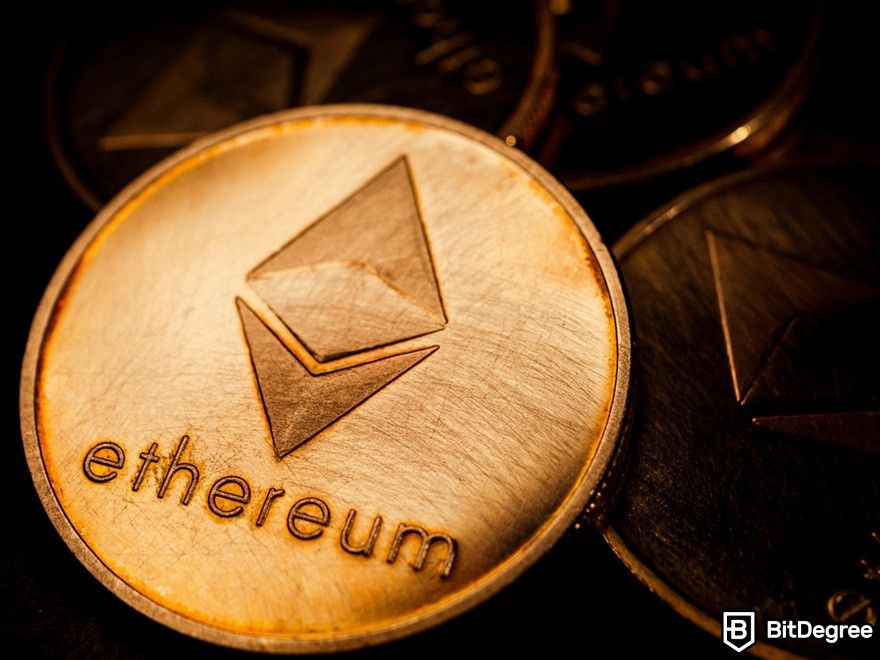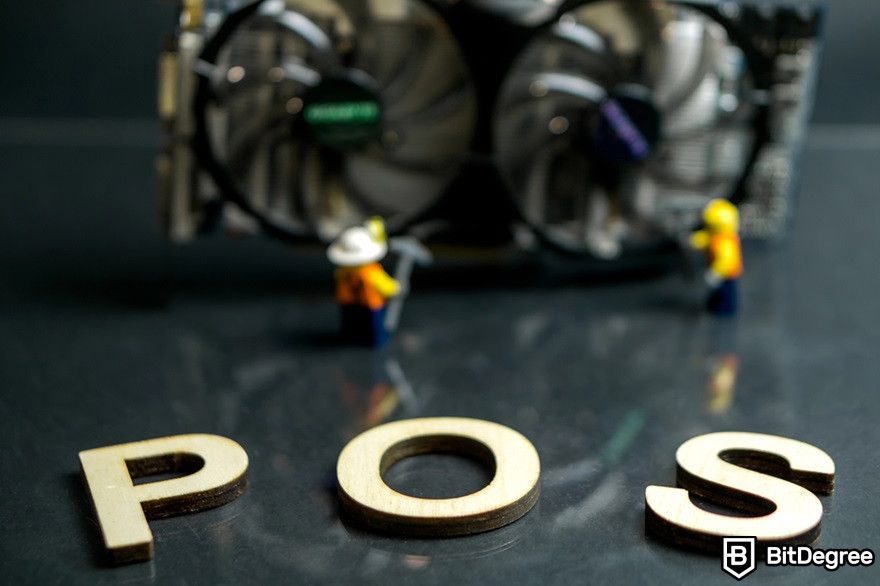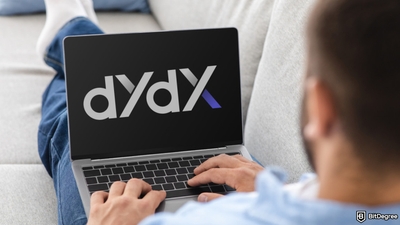Key Takeaways
- A crypto token refers to a digital asset developed on blockchain technology that provides multiple functionalities, from granting access to exclusive content to representing ownership of real-world assets.
- The history of crypto tokens is closely linked to the evolution of blockchain technology and the rise of cryptocurrencies.
- Compared to crypto coins that are built on a dedicated blockchain, a crypto token is built on existing blockchains.
Free Airdrop Season 7 is LIVE! Answer fun questions or do simple tasks to earn rewards from the $30K BitDegree prize pool. Participate Now ! 🔥
Forget the fear of missing out (FOMO) on the latest crypto buzzwords! I’m here to explain one term with massive potential: a crypto token.
Unlike crypto coins which are mostly used for transactions (storing value and working as a medium of exchange), crypto tokens unlock a wide range of possibilities.
Imagine in-game items you truly own, voting rights in a decentralized project, or even fractional ownership of real-world assets – all powered by these digital tokens.
But with great potential comes responsibility! Keeping your crypto tokens safe is crucial. That's where secure storage solutions like Ledger Nano X come in. This hardware wallet provides a safe and offline environment for your tokens, giving you peace of mind while you explore the exciting world of crypto.

Did you know?
Subscribe - We publish new crypto explainer videos every week!
What is a Bitcoin Faucet? Pros & Cons Explained (With Animations)


Table of Contents
What is a Crypto Token?
Crypto tokens are digital assets built on blockchain technology. Unlike traditional currencies, these blockchain tokens aren't solely used for transactions or as a store of value[1].
Latest Deal Active Right Now:Head to BitDegree Missions, gather as many Bits as possible & claim your stake of the $30,000 Prize Pool! Don't waste your time & start collecting Bits by completing Missions and referring friends.
They offer a wider range of functionalities within the decentralized world, including:
- Digital representations of assets. Tokens can act as digital certificates of ownership for real-world assets[2] like property or artwork.
- Ownership stakes in a project. Owning a token might grant you a share of ownership in a decentralized project, similar to holding stock in a company.
- Voting rights within a platform. Some tokens allow holders to participate in governance decisions on a blockchain network.
- Access to services within dApps. Decentralized applications (dApps) are applications built on blockchain technology. Owning specific tokens might grant you access to exclusive features or functionalities within these apps.
This versatility makes crypto tokens an essential component in the digital economy, enabling new business models and financial innovations.
For example, Initial Coin Offerings (ICOs) allow startups to raise capital directly from the public by offering utility tokens that grant access to their platform or services. This outperforms traditional venture capital routes.
Programmable crypto tokens also promote innovative ideas. Imagine loyalty programs that reward you instantly, supply chains with complete transparency, and secure voting systems.
Types of Crypto Tokens
We’ve discussed the question, “What is a token?” and some functionalities. However, the world of crypto tokens can be quite diverse. To help you navigate, here are some of the main types you'll encounter:
- Utility tokens
- Security tokens
- Non-fungible tokens (NFTs)
- Governance tokens
This is not an exhaustive list, but it covers the main types of crypto tokens you're likely to hear. The crypto space is constantly evolving, so new types of tokens may emerge in the future! In the meantime, let's go into the details of each token mentioned above.
When it comes to utility tokens, they each have some specific purpose(s). They can provide access to a specific service or platform within a blockchain ecosystem, or they can also be used to raise capital for project development. A popular example is the Basic Attention Token (BAT), which allows users to earn rewards for viewing ads in the Brave browser and pay for advertising services.
Of course, there are many more types of utility tokens apart from the ones I've mentioned.
If we talk about security tokens, they’re fundamentally different from utility tokens. They represent ownership in real-world assets such as stocks, bonds, or real estate, which are subject to regulatory oversight and are designed to comply with securities laws.
Security tokens offer potential benefits, such as fractional ownership, allowing smaller investments in traditionally high-barrier-to-entry assets. They can also increase liquidity by facilitating easier trading compared to traditional methods. Additionally, automated compliance features within the blockchain can streamline regulatory processes.
Now, “What are tokens I usually find in video games?”, you might ask. The answer is non-fungible tokens.

These are unique digital assets that represent ownership of a specific item, such as digital art, collectibles, or in-game assets. They use blockchain technology to verify authenticity and ownership, providing a new way to buy, sell, and trade digital assets.
Each NFT is distinct and can’t be exchanged on a one-to-one basis with another NFT.
CryptoKitties is one of the popular examples of NFT collections. Every NFT represents a unique digital cat with its own set of characteristics, like fur color, eye shape, and even special traits. These traits determine the asset's rarity and value. Players can breed their CryptoKitties to create new generations, adding a layer of strategy and collectability.
Lastly, there are governance tokens. These tokens grant holders the right to participate in the decision-making processes of a decentralized organization or protocol. Holders can vote on proposed changes, upgrades, or other key issues affecting the network.
Additionally, when talking about a crypto token, you’re also likely to catch the terms “fungibility” and “indivisibility”. Fungibility means whether tokens can be exchanged for one another and hold the same value (like money). Meanwhile, indivisibility refers to whether a token can be broken down into smaller parts. Most tokens are indivisible.

If you're still confused about the concept of token types and their functionalities, imagine your favorite amusement park or playground – to access them, you might need special passes.
In the world of blockchain, these passes are called tokens! What are tokens, then? Similar to how tickets at an amusement park grant access to different rides and games, think of them as digital keys that unlock features within a specific digital ecosystem.
There are many different types of tokens, each granting access to unique experiences and utilities. Examples are making payments within a decentralized application (dApp), participating in governance decisions, or accessing exclusive content.
The type of token determines the specific "ride" or feature it grants access to within the playground.
So, next time you hear about crypto tokens, remember – they're your digital ticket to a whole new world! With a wide variety available, these tokens unlock many possibilities, from seamless in-app payments to shaping the future of online communities. The key is finding the right token for the specific "playground" and experience you want.
History of Crypto Tokens
The history of crypto tokens is intertwined with the development of blockchain technology and cryptocurrencies.
Pioneering ideas like David Chaum's eCash (1983) and Wei Dai's B-Money (1998) laid the foundation for digital currencies with secure and anonymous transactions. These concepts paved the way for digital tokens as a form of electronic cash.
The launch of Ethereum, a programmable blockchain network, in 2014 marked a significant turning point. Unlike Bitcoin, Ethereum allows developers to create and deploy smart contracts, self-executing programs on the blockchain. This opened doors for more token functionalities beyond just representing assets.
In 2015, the ERC-20 token standard was introduced on the Ethereum blockchain. This standardized how tokens interact with the network and other applications built on Ethereum, helping developers create and integrate them into various projects.

ERC-20 tokens are compatible with the Ethereum network. It's fast, convenient, and cost-effective for companies to create ERC-20 tokens for their ICOs. Investors also benefit from the ease of trading and using ERC-20 tokens on various Ethereum-based exchanges.
Think of ERC-20 as a recipe for creating cookies. This token provides the technical foundation (the recipe) for creating tokens. Then, ICOs use ERC-20 tokens as a fundraising tool (selling the cookies).
Between 2017 and 2019, the popularity of Initial Coin Offerings surged.
ICOs are fundraising events for cryptocurrency projects, where companies raise capital by creating new digital tokens and selling them to investors in exchange for established cryptocurrencies, like Ether (Ethereum's native currency). These tokens can represent various things, like future access to a company's service or a share of ownership in the project.
On the other hand, in 2017, the rise of decentralized finance (DeFi) platforms began to show the potential of tokens beyond fundraising. Projects like MakerDAO used tokens for governance and to facilitate decentralized lending and borrowing.

In the next year, ERC-721 tokens were released and enabled the creation of non-fungible tokens (NFTs). Unlike ERC-20 tokens, which are fungible, ERC-721 tokens are unique and indivisible. This new standard paved the way for digital collectibles and new applications in gaming and virtual assets.
In 2017-2018, ICOs became an even more popular fundraising method for blockchain projects. Investors poured billions into these ventures, often based on little more than a whitepaper (a promotional document outlining the project) and ambitious promises.
However, the ICO boom led to increased regulatory scrutiny, as many projects were accused of fraud or failing to deliver on their promises. Governments and regulatory bodies worldwide began to develop frameworks for regulating token sales and ensuring investor protection.
For example, the US Securities and Exchange Commission (SEC) took a hard stance, classifying many ICO tokens as securities. This meant they fell under existing securities regulations requiring stricter disclosures and investor protections. Meanwhile, China took a more drastic approach, completely banning ICOs in 2017.

Despite regulatory challenges to raise money by selling digital tokens, the whole system for these tokens kept growing, including the creation of new inventions like ERC-1155. It allows developers to make fungible and non-fungible tokens within the same contract. This period also marked the launch of security tokens, which are designed to comply with securities regulations.
In 2020, decentralized finance (DeFi) saw explosive growth, with tokens playing a central role in protocols for lending, borrowing, trading, and yield farming. Governance tokens became important to the operation and evolution of these decentralized platforms, as they give token holders a say in how the DeFi protocols are run and evolve.
Until now, the crypto token ecosystem continues to evolve, with innovations in interoperability, scalability, and regulatory compliance.
For instance, Layer-2 solutions are created as protocols built on top of existing blockchains to increase transaction speed and reduce costs. Alternative networks like Solana and Cardano also aim to address slow processing times and high fees.
How Crypto Tokens Work
While I've talked a bit about how crypto tokens work, let's get into more details here!
Crypto tokens are typically created on existing blockchain networks such as Ethereum, BNB Chain, and Solana. These platforms provide the underlying infrastructure and protocols necessary for the creation and management of tokens.
Smart contracts, self-executing programs written in code that reside on a blockchain, are crucial in the functionality of crypto tokens. It automates tasks and interactions within the ecosystem.
Imagine a vending machine; you insert the exact amount of money (representing crypto tokens) and press a button for your desired item. Then, the vending machine (acting like a smart contract) automatically verifies your payment and dispenses the item based on predefined rules.
These contracts can be programmed to handle various tasks related to crypto tokens, such as:
- Token creation. Smart contracts can define the initial token supply, how new tokens are created (if applicable), and how they’re distributed.
- Token transfers. When you send these blockchain tokens to someone else, a smart contract can automatically verify the transaction, ensuring you have sufficient funds and are following the predefined transfer rules.
- Escrow services. Smart contracts can act as secure intermediaries. They will hold tokens until certain conditions are met before releasing them to the intended recipient. This can be useful for transactions where trust needs to be established between two parties who don't know each other.

- Access control. Developers can use smart contracts to grant access to specific features or services within a blockchain application based on token ownership. For example, a game may require players to hold a certain amount of tokens to access exclusive content.
- Automated payments. Smart contracts can automate recurring payments or dividends associated with certain tokens. For example, a security token representing ownership in a company can use this technology to distribute dividends to token holders automatically.
When we talk about token standards, crypto tokens have a set of rules that define how they’re created and interact with the blockchain. Common standards include the aforementioned ERC-20 for fungible tokens and ERC-721 for non-fungible tokens.
These standards promote compatibility and interoperability within the blockchain ecosystem. This translates to easier token exchange, integration with various applications, and a more vibrant in-game economy.
For example, let's say you own a game that uses ERC-721 tokens to represent unique in-game items. These items, like special weapons or rare character skins, are non-fungible, meaning each one is one-of-a-kind and can’t be replaced by another identical item.
Thanks to the ERC-721 standard, your game can seamlessly interact with other wallets and marketplaces supporting the same token. Crypto tokens with this standard also enable players to securely trade or sell their in-game items with other players, even if those players use different wallets or platforms.

Similarly, ERC-20 is a standard designed for fungible assets. It can be used for various purposes within a blockchain ecosystem.
Imagine a play-to-earn game where players earn ERC-20 tokens by completing tasks or winning battles. These blockchain tokens can then be used within the game to purchase upgrades, access exclusive content, or even be traded on cryptocurrency exchanges for other digital assets or fiat currency.
Standards like ERC-20 and ERC-721 act as a universal language for a token. Crypto enthusiasts and developers can use these to ensure compatibility and smooth interaction between different blockchain applications and wallets. This, in turn, builds a more diverse and interconnected experience for users.
Crypto tokens can be stored and transferred in digital wallets, similar to sending money between bank accounts. The transactions use the power of blockchain technology to ensure security through complex cryptography, where a private key acts as the only way to access and control your tokens. This security is crucial, as losing your private key essentially means losing access to your tokens.
This is where hardware wallets like Ledger Nano X come in. This wallet takes security a step further by providing cold storage. Unlike hot wallets (which are software wallets constantly connected to the internet), Ledger wallets store your digital tokens offline on a secure hardware device.
Moreover, Ledger supports a variety of cryptocurrencies and tokens, including thousands of tokens across different blockchains. Though, while it has its own software interface (Ledger Live), it can also be used with compatible third-party software wallets. These wallets might offer wider token support or additional features for managing your tokens.
Crypto Tokens VS Cryptocurrencies VS Altcoins
In the world of cryptocurrency, terms can get tossed around and sometimes used interchangeably, but there are distinct differences between a crypto token, cryptocurrency, and altcoin.
Cryptocurrencies are the umbrella of all terms involving crypto assets.
Meanwhile, altcoins are short for "alternative coin." Simply put, any cryptocurrency other than Bitcoin is considered an altcoin. Altcoins can be divided into several categories based on their features and uses, such as transaction-focused coins, privacy coins, stablecoins, and platform-based coins.
We can also divide cryptocurrencies into coins and tokens.
Crypto coins refer to digital assets designed to function as a medium of exchange – think of them like digital cash. Bitcoin, one of the most well-known examples, is used for peer-to-peer transactions without relying on banks. These assets typically have their own dedicated blockchain.
On the other hand, crypto tokens represent a broader category if we talk about their functionalities – they act not just as a medium of exchange. Unlike crypto coins, which have their independent blockchains, tokens are built on top of other blockchain networks, such as Ethereum and BNB Chain.
Still confused about the differences between crypto tokens and crypto coins? No worries! Here's a clarification of several aspects with a quick breakdown of these terms.
| Crypto coins | Crypto Tokens | |
| Definition | Digital money for transactions | Digital assets built on existing blockchains |
| Primary Use Case | Medium of exchange, store of value | Access to services, governance, ownership |
| Own Blockchain | Yes | No (built on existing blockchains) |
| Examples | Bitcoin (BTC), Litecoin (LTC) | Basic Attention Token (BAT), Maker (MKR), NFTs |
| Fungibility | Fungible (can be exchanged equally) | Varies (depends on token type) |
Table: The comparison of crypto tokens and coins.
To conclude, the underlying infrastructure of blockchain technology is the main difference between a coin and a token. Coin creation has its dedicated blockchain, while a token uses existing blockchain networks like Ethereum.
How New Crypto Tokens are Created
At this point, you already know the answer to, “What is a token?” along with the history and how it differs from crypto coins. Now, let’s delve deeper and explore a step-by-step guide to creating a new crypto token and various methods to turn an idea into a tangible digital asset.
A Step-by-Step Guide
Creating a new crypto token involves several steps, which can vary based on the chosen method. However, here’s a general guide to get you started:
Step 1: Determine whether it will be a utility token, security token, governance token, or non-fungible token (NFT). If you have a question, "What are tokens the most suitable for my project?", define their functionality, such as granting access to a service, representing ownership, or enabling voting.
Step 2: Choose the blockchain network that best suits your needs:
- Ethereum is popular due to its advanced smart contract capabilities and widespread adoption.
- BNB Chain offers lower transaction fees and faster processing times.
- Solana is known for its high throughput and low costs.
You can also consider other networks like Polkadot, Cardano, or Tezos based on specific requirements, such as customization and interoperability.
Step 3: Choose the appropriate standard. Common standards include:
- ERC-20: For fungible tokens on Ethereum.
- ERC-721: For non-fungible tokens (NFTs) on Ethereum.
- ERC-1155: For both fungible and non-fungible tokens on Ethereum.
- BEP-20: For fungible tokens on BNB Chain.

Step 4: Develop and test the smart contract using development tools like Remix, Truffle, or Hardhat, primarily in Solidity for Ethereum-based tokens. Then, follow best practices to ensure security and functionality and conduct thorough testing on a testnet to identify and fix any issues. Ensure that you simulate various conditions to see whether the contract performs as expected.
Step 5: Once testing is complete, deploy your smart contract on the mainnet. Be aware of the gas fees associated with deployment, especially on Ethereum. Deploying on the mainnet makes your token live and available for interaction.
Step 6: Verify your contract on the blockchain explorer, such as Etherscan for Ethereum, to provide transparency and build trust. Next, make your contract code public to allow others to review and audit it.
Step 7: Finally, get your token in users' hands! Distribute them based on your plan, which could involve giving them away (airdrops), selling them, or rewarding users for participating in your project. Make sure your token works with popular wallets, so people can easily store and manage them.
Terms Related to Token Creation
Now, to equip you further on your crypto journey, here are some terms you might encounter when delving into the topic of crypto tokens. I'll explain these key concepts to ensure a clear understanding.
- Initial Coin Offerings (ICOs)
- Initial Exchange Offerings (IEOs)
- Security Token Offerings (STOs)
- Mining (for Proof-of-Work Blockchains)
- Staking (for Proof-of-Stake Blockchains)
- Minting
What is a token creation term that applies to your needs? Let's unpack each concept as each of these comes with its own set of regulations and requirements.
Initial Coin Offerings (ICOs), Initial Exchange Offerings (IEOs), and Security Token Offerings (STOs)
ICOs, IEOs, and STOs are like crowdfunding, but with crypto tokens! These fundraising options let you sell brand-new tokens to raise money and get your project off the ground.
In the early days of crypto tokens, ICOs were like a public announcement to introduce a new idea and raise capital. Here, you create new tokens for the project and sell them to investors in exchange for popular digital assets (like Bitcoin or Ethereum) or fiat money (like US Dollars).
However, ICOs became associated with scams and unregulated offerings. Many jurisdictions have implemented regulations or restrictions on ICOs.

Seen as a more regulated alternative to ICOs, IEOs are conducted through established cryptocurrency exchanges. It's like having a popular store sell your tokens for you. The exchange checks if your project is legit and then offers your tokens to their users. IEOs can be a safer option for investors because the exchange has reviewed the project beforehand.
Meanwhile, STOs are like selling shares in a company through a regulated stock exchange. They represent ownership in real-world assets like stocks, bonds, or real estate.
An STO is similar to an ICO but with stricter rules and regulations. This is because security tokens represent actual investments, and there are more legal requirements to ensure everything is fair and transparent.
Mining, Staking, and Minting
To understand the term "mining", imagine you're a gold miner. However, instead of digging for gold, you're using powerful computers to solve complex math problems. These problems are like security checks for transactions on a blockchain network (like Bitcoin). The first one to find a solution gets rewarded with "newly created tokens". This is how new coins are created in a Proof-of-Work blockchain system.
So, what are tokens created through in Proof-of-Stake blockchains? In PoS systems, new tokens are generated through a process known as staking, which is typically more energy-efficient than Proof-of-Work mining.

Think of staking like locking up your money in a bank certificate of deposit (CD). Your money helps secure the bank's operations (like staking secures the blockchain), and you earn interest in return.
Anyone who owns a certain amount of crypto on a Proof-of-Stake blockchain can stake their coins.
You don't need powerful computers for staking. Instead, your crypto acts like a vote to validate transactions on the network.
Meanwhile, minting is the broader term encompassing the creation of new crypto tokens. It can happen through mining (PoW) or staking (PoS), but also through other mechanisms like decentralized applications.
Think of minting like creating new entries on a membership list (the blockchain). Minting adds new "tokens" (memberships) to the network.
In PoW and PoS systems, miners and stakers indirectly create new tokens through their activities (mining and staking). In other minting mechanisms, developers or dApps might be responsible for creating new tokens.
Conclusions
What is a crypto token? It's a digital asset built on top of an existing blockchain network. This asset represents many functionalities, from in-game ownership to voting rights.
While the technical aspects might seem complex at first, understanding the core concepts – like the difference between coins and tokens, or the various functionalities tokens can offer – gives you the foundation to navigate this exciting new world.
Regardless of the type of crypto tokens you hold, safeguarding your digital holdings is crucial. Hardware wallets from Ledger offer a reliable and user-friendly solution to ensure your crypto remains secure, letting you focus on exploring the possibilities of this innovative technology.
The content published on this website is not aimed to give any kind of financial, investment, trading, or any other form of advice. BitDegree.org does not endorse or suggest you to buy, sell or hold any kind of cryptocurrency. Before making financial investment decisions, do consult your financial advisor.
Scientific References
1. P. Freni, E. Ferro: ‘Tokenomics and Blockchain Tokens: A Design-Oriented Morphological Framework’;
2. J. Chod, E Lyandres: ‘Product Market Competition With Crypto Tokens and Smart Contracts’.
















